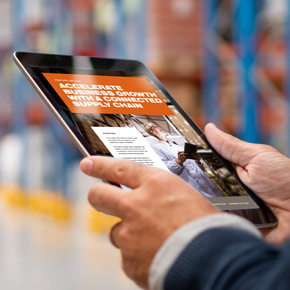
In the past, companies relied on the shared knowledge of a handful of people within an organization – and sometimes just one person – to plan and manage supply chain requirements. Supply Chain Management (SCM) consisted of phone calls, desk calculators and spreadsheets to ensure that components and raw materials came in at the right time and in the right quantities.
Powerful personal computing and enterprise level software has made SCM more accurate and increasingly capable of handling large amounts of data. Yet, pencil and paper methods, as well as spreadsheet calculations and a heavy reliance on phones and email, has allowed planning to remain a broadly human endeavor.
Digitizing for Disruption
Today, the trend of hybrid SCM systems where physical inputs are augmented by some automation is rapidly giving way to agile, fully digitized supply chains. These can deliver more accurate analysis, identify deeper trends and do so at speeds that wouldn’t be possible by human decision-making alone. And these digitized systems have come along just in time, as normal everyday disruptions have been compounded by major events that ripple across the globe.
While missed ships, equipment breakdowns and other standard issues are a constant cause for headaches, new disruptions such as trade and tariff wars, international events and pandemics such as COVID-19 are wreaking havoc like never before. As a result, this combination of normal and new patterns of disruption now make digitization of the supply chain mission critical, as no company can manage them with brain power alone.
Benefits of Digitization
As companies struggle to find their new normal, the focus in SCM has shifted toward faster iterative cycles, more accurate forecasting and robust “what-if” scenario planning to develop contingency plans and stay ahead of the “potential problem” curve. And as digitization of the supply chain becomes more critical, the advantages offer a way to beat disruption in real time. Key Benefits of digitization include:
- Forward-looking capability – One survey by Supply Chain Digest states that a digital supply network allows companies to become more forward-looking. The backward-focused historical approach is now augmented by real-time analytics that empower much greater forecast accuracy. This enables a deeper understanding of what might happen, based on all variables and not just historical data.
- More flexibility – With events in supply chain legs happening faster and with more severity, flexibility through digitized networks is becoming increasingly vital. The old view of the quarterly or yearly plan often requires adjusting in real-time and at a pace humans can’t keep up with. Through digitization, planning moves away from being “period driven” and becomes a continuous process . This allows changes and adjustments to be automated and shared across the network to smoothen the disruption or trigger contingency suppliers and other solutions.
- Better accuracy – Because the software that drives digitized supply chains requires data that isn’t siloed, it creates transparency across the network. This helps eliminate redundant efforts, reduce errors and assists all stakeholders within the supply chain to operate with a single, consistent set of data. This transparency and single source of truth leverages the accuracy and analytics. This in turn enables high level enterprise KPIs as well as granular warehouse, bin, shop floor and machine-level data to provide actionable insights and even make prescribed decisions automatically.
- Lean efficiency – In a world of disruption many companies have come to rely on work-from-home teams as part of their COVID-19 mitigation strategy. In the past, this would have created its own disruption by spreading out teams relying on heavy interpersonal contact and physical inputs into the system to “get things done”. Digitized supply chains offer the opportunity to automate functions that eliminate both physical activity as well as some planning tasks. This makes remote teams just as strong as in-house teams. And in the case of companies who have reduced staffing levels during the pandemic, enhances the effectiveness of remaining personnel through automation, transparency and analytical capability.
- Data-driven planning – The combination of advanced analytics, standardized data and iterative real-time planning allows for visualization of data at a new level. When people can visualize the data and are confident in its accuracy and quality, applying it to create solutions is easier. Because planning is data driven, stakeholder collaboration is higher.
Beating back today’s disruptive forces on already strained supply chains isn’t easy. But with a digitized supply chain, software designed for design and supply planning such as DemandCaster’s Supply Chain Planning Software Suite, you can race ahead of competitors with a data-driven, transparent planning process that takes advantages of all the benefits above and more.
State of Supply Chain – How to Keep up During Rapid Change
Remaining agile, adapting, and mitigating risks are top concerns for supply chain leaders. Unfortunately, last we checked, there isn’t a playbook for this new reality.
But we do have each other to learn from. Watch this on-demand discussion from a panel of experts to share what it really means to ‘adapt’ during a global pandemic.



